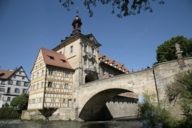
Anyone travelling to the north of Bavaria can also expect a little bit of south, given that Bamberg is also known as Little Venice or Franconian Rome. And even when far removed from Italy itself, there is still lots to discover in the Upper Franconian city.
- Bamberg: UNESCO World Heritage Site
- Between Rome and Venice – the Italian side of Bamberg
- Bamberger Dom, Alte Hofhaltung and plenty of beer
- Bamberg: How to get there from Munich
Bamberg is an island town – the Regnitz river branches to the left and right around the historic city. Enveloped by this stunning scenic backdrop, one early medieval building adjoins the next. Also, given that Bamberg remained virtually untouched by the Second World War, it is still wonderful to take in its old threefold structure: the spiritual Bergstadt, the bourgeois Inselstadt and the Gärtnerstadt districts.
In addition to beer, Bamberg is also known for its gardening businesses, which visitors can take in. Anyone visiting the city located in Upper Franconia immediately grasps why it has been a UNESCO World Heritage Site since 1993.
Situated directly on the Regnitz river is the old fishermen’s settlement with historic houses dating from the 17th century. Although they all originate from the same era, no two buildings look the same. These houses used to have their own boat garages situated on the eastern shore, while the vessels that traversed the waters here would carry various goods. Today, only passenger boats sail the waters here, revealing to all who arrive this most special spot in Bavaria. If you are looking for that very Italian feeling, why not rent a genuine Venetian gondola and float along the river.
But this is not the only place in Bamberg that is reminiscent of Italy. Germany’s largest medium-size city – home to roughly 78,000 inhabitants – was built like Rome on seven hills – including the Stephansberg, the Domberg and the Altenburg. Hence, the city’s epithet is also “Franconian Rome”. If you stroll through the narrow alleys of Bamberg – e.g. on a walk up to the Stephansberg – or roam through the cobblestone streets and admire the colourful little houses, including some from the 15th century, you really feel like you could be in Italy.
But even if we move away from its Mediterranean charm, the city has lots to offer. The Bamberger Dom (cathedral) with its four towers is a front-running contender. The cathedral celebrated its millennial anniversary in 2012 – the first mention of “Babenburg”, however, dates back even further. Over the centuries, the Bamberger Dom suffered two major fires and had to be rebuilt. It is not only the Bamberger Reiter – a statue from the 13th century – which stands here today (and which went on to become one of the city's most enduring landmarks), it is also the only final resting place for a pope in Germany today.
Furthermore, on the Domberg (situated right alongside) there is the Alte Hofhaltung, consisting of several episcopal residential and commercial buildings dating from the 15th century. The city’s historical museum located right inside is also worth a visit. However, from the year 1602 onwards, the Hofhaltung and its function as a residence was replaced – this was followed by the Neue Residenz (New Residence), which can still be visited today and which not only houses the state library and gallery, but also the stunning rose garden, where thousands of roses bloom every year.
One of the most popular photo opportunities the city of Bamberg has to offer is located not only right on the water itself, it was even built in the middle of the Regnitz: this is the Alte Rathaus (old town hall). First mentioned in 1387, the building was erected in the Gothic style at that time, before it was later remodelled in the styles of Baroque and Rococo. Today, no one convenes or goes about their official duties here; it is, however, home to one of the largest porcelain collections in Europe.
In Bamberg’s wonderful restaurants, guests can enjoy a typical Franconian “Schäuferla”, a cut of pork shoulder, naturally served on sophisticated porcelain. Given that the city is best known for its beer, guests should definitely try the “Rauchbier”, a special type of beer which is produced by using smoked malt. And if that is not enough beer for you, then why not have a look at the Fränkische Brauereimuseum (museum).
Train connection: about 2 hours. More information under bahn.de
Car: about 2,5 hours via the A9, A3 and A73 motorway